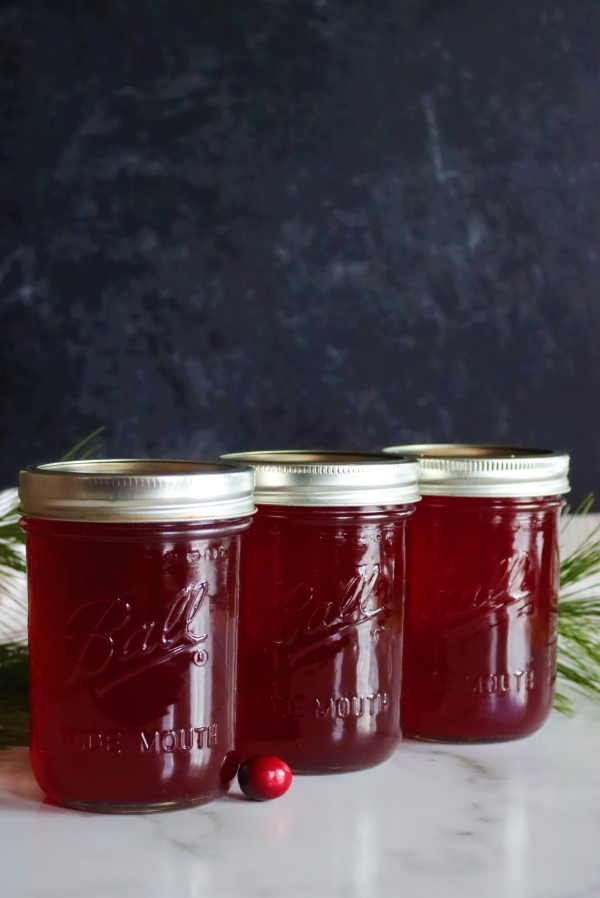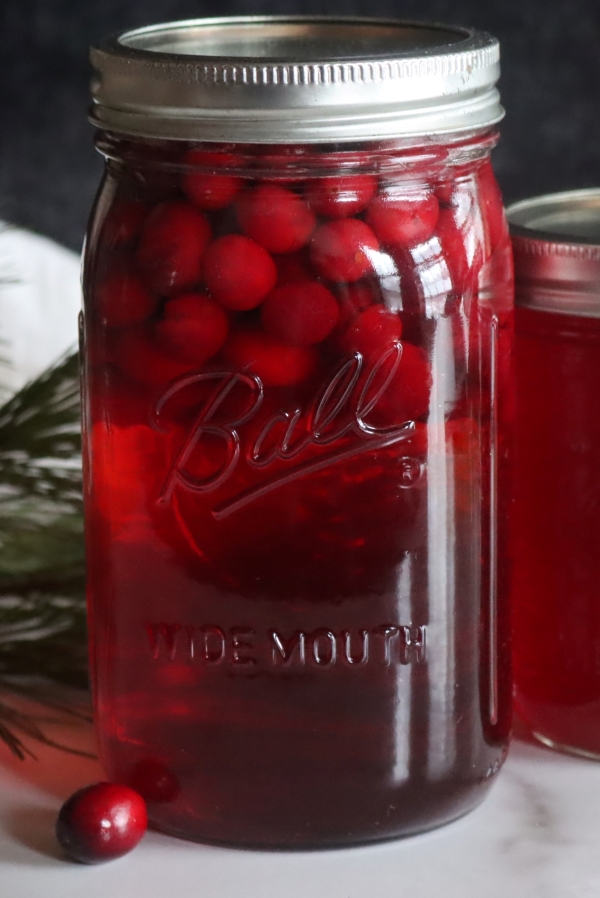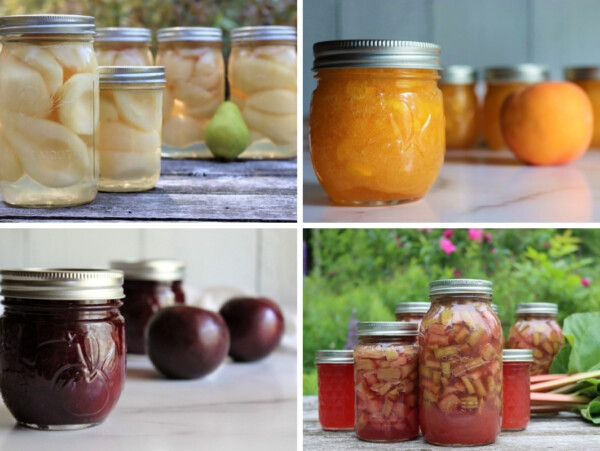Affiliate disclosure: This post may contain affiliate links. Please see our Privacy Policy.
Canning cranberry juice at home means you control the quality of the fruit, the strength of the juice, and most importantly, the amount of sugar (if any). There are two basic methods, and both are simple water bath canning recipes.

Fresh cranberry juice is absolutely delicious, and infinitely better than the corn syrup sweetened “cranberry cocktail” you find in the grocery store.
That stuff has just enough cranberry in it to make it red, and not a drop more.
Homemade cranberry juice, on the other hand, is the real deal.
Personally, I love plain unsweetened cranberry juice, and I’ll can it up fresh that way. I don’t drink it in whole glasses, just a dash at a time into a bit of plain seltzer from our soda stream.
It makes something that’s a bit like lemon water, but better in my opinion.
You can also can sweetened cranberry juice, with as much (or as little) sugar as you’d like.
There are two main ways to get the job done:
- Canning cranberries with sugar and water, then waiting for the juice to extract naturally in the pantry. The juice is then filtered out when you want to consume it (weeks or months later).
- Extracting cranberry juice (as you would to make cranberry jelly) and then canning the extracted juice.
Simply tossing the cranberries in a jar is quicker, but yields a less concentrated juice. Extracting the juice first takes more effort, but then you can put up cranberry juice without sugar that’s perfect for adding concentrated flavor to other drinks (or taking for UTIs).

Extracting Cranberry Juice for Canning
To can plain cranberry juice (without added sugar), you’ll need to first extract the juice from fresh (or frozen) cranberries.
To make a 7 quart canning batch, you’ll need about 3 lbs of cranberries. For a more concentrated juice, you can add more cranberries. Some recipes recommend as much as 3 lbs of cranberries per quart of extracted juice, and that is indeed intense (quite concentrated).
I’d recommend starting with 3 lbs of cranberries, and if you want the juice more concentrated, double it next time (leaving the water the same).
We grow our own cranberries, but if you’re buying them from the store they usually come in 12 oz bags. You’ll need 4 bags (12 oz each) to make 3 lbs of cranberries.
Place the cranberries in a large stock pot with 4 quarts of water. Bring the mixture to a simmer and cook for about 5-10 minutes until the berries pop.
Strain through a double layer of cheesecloth, or a jelly bag.

At this point, you’ll have about 4 quarts of cranberry juice, but the pulp still has a lot of cranberry flavor left. You can stop here if you want, but I’d recommend doing a couple more extractions.
Pour the cranberry pulp back into the pot with 2 quarts water this time, and simmer for another 5 minutes. Strain again.
Then do one more extraction with 1 quart of water, simmer again for 5 minutes. Strain one last time.
You should, at this point, have roughly 7 quarts of extracted cranberry juice. The pulp should be quite pale at this point, with minimal flavor left.
(Again, for more concentrated juice, you can start with A LOT more cranberries, but this amount yields a good tasting juice, and a really concentrated cranberry juice is unpalatable to most people. Either way, you may need to dilute at serving anyway.)
Canning Cranberry Juice
Once you’ve extracted the juice from your cranberries, canning is pretty simple.
If you’re not familiar with canning, I’d suggest you read my beginners guide to water bath canning before you get started.
Prepare a water bath canner, canning jars and lids.
Pour the strained juice back into a stock pot and warm it to about 180-190 degrees. This is just barely simmering, but not boiling. Do not boil the mixture, as you want juice (not jelly).
Add sugar to taste, and stir to dissolve. Cook the juice as little as possible here, especially once sugar is added, since it will turn to jelly quite quickly.
(Freezing the cranberries before extracting the juice helps prevent it from turning to jelly, as freezing fruit for 1 week reduces the pectin content by half. I’d suggest pre-freezing the fruit for a week if you’re going to add sugar when canning cranberry juice.)
Ladle the cranberry juice into canning jars, leaving 1/4 inch headspace.
Load the jars into a water bath canner that’s just barely simmering. Turn up the heat and bring it to a full rolling boil. Once the canner is boiling hard, start the timer.
Process pints and quarts for 10 minutes at a full rolling boil if below 1,000 feet in elevation. For higher elevations, process jars for 15 minutes.

Canning Cranberries for Juice (Filtered Later)
There is another way to can cranberry juice, and honestly, this is what I see most people doing.
This method is simpler, since you don’t actually make cranberry juice first. You just simply toss a few handfuls of cranberries in each jar, cover with a bit of sugar and then top with boiling water before canning.
It’s so incredibly simple, and saves a lot of time during cranberry season (when everyone’s busy with the holidays anyway).
The downside is that it only works if you’re adding sugar to the jars, since the sugar is what helps draw the juice out of the berries. It’s not a great option for unsweetened cranberry juice.
It’s also not a great option if you want really concentrated cranberry juice.
This will yield a juice that’s sweet and light, perfect for straining and drinking over ice with no other preparation (or dilution).
That’s honestly what most people want anyway.

Start by adding about 1 1/2 to 1 3/4 cups of cranberries to each quart jar. A single 12 oz bag of cranberries is about 3 cups, so each one will make roughly two quarts of juice.
For a 7 quart canner batch, I usually just round it out so I’m using 4 bags of cranberries to make 7 jars (that’s 1 3/4 cups per jar).
Top the cranberries with about 1/2 cup of sugar. You can adjust the sugar to your tastes, and use less if you’d like. Don’t use less than 1/4 cup because the syrup will be too weak to extract juice from the berries in the jar.
Again, if you’d like unsweetened cranberry juice I’d recommend using the other method and juicing the cranberries first.
Prepare a water bath canner and get your lids ready.
Pour boiling water over the cranberries and sugar, leaving 1/2 inch headspace. Seal with 2 part lids.
Bring the canner to a full rolling boil, and then start the timer.
Process the jars in a water bath canner for 25 minutes (both pints and quarts) if under 1,000 feet in elevation. (For 1,000 to 6,000 feet process for 30 minutes, and above 6,000 feet process for 35 minutes.)

When you pull the jars out of the canner, they’re not ready yet.
You’ll notice the “juice” is still clear in the jars, as it needs time to fully infuse from the cranberries.
At this point, the cranberries are cooked and canned, but the juice won’t be ready to drink for another 4-6 weeks.
Check jar seals, and store sealed jars in the pantry. After 4-6 weeks, the juice will have extracted fully and you can begin enjoying your home canned cranberry juice.
Just strain and enjoy over ice.

Ways to Preserve Cranberries
Need a few more ways to preserve cranberries?
- Canning Whole Cranberries in Syrup
- Canning Cranberry Sauce
- Honey Fermented Cranberries
- Pickled Cranberries
- Cranberry Wine

Canning Cranberry Juice (Two Ways!)
Equipment
Ingredients
- 3 lbs cranberries, 4 bags, 12 oz each
- 7 quarts water
- 1 3/4 to 3 1/2 cups sugar, see note (optional)
Instructions
Pre-Juiced Method
- This method has you juice the cranberries first, and then can the extracted juice. This is more work up front, but you don’t have to strain the juice before using. Use this method for unsweetened cranberry juice, as the 2nd method only works if you add sugar.
- Add 3 lbs cranberries (four 12 oz bags) to a large stock pot, along with 4 quarts of water. Bring the pot to a boil, and then simmer for 5-10 minutes until the cranberries pop.
- Strain the cranberries through a double layer of cheesecloth, or a jelly bag, for about 30 minutes. Collect the juice.
- Return the cranberry pulp to the stock pot, add two more quarts of water and bring it back to a simmer for 5 minutes. Strain agin for 10-15 minutes.
- Return the pulp to the pan a 3rd time with 1 final quart of water. Return to a simmer for 5 minutes, stirring to extract the last bits of juice.
- Strain one final time, and discard the pulp.
- Prepare a water bath canner and jars. Bring the canner to a simmer (around 180 degrees).
- Return the juice to a clean stock pot and warm it to just barely simmering (180 to 190 degrees F). Do not boil!
- Add sugar to taste, if you choose. I’d suggest around 1 3/4 cup for tart juice, or up to 3 1/2 cups for sweet juice. Omit the sugar for sugar free juice. Stir to dissolve the sugar, but don’t overcook (or it’ll become jelly).
- Ladle the juice into prepared canning jars, leaving 1/4 inch headspace. Seal with 2 part canning and load into the canner.
- Return the canner to a hard boil and process jars (pints and quarts) for 10 minutes below 1,000 feet in elevation. Increase time to 15 minutes if over 1,000 feet.
- Remove jars to cool on a towel on the counter and check seals after 24 hours. Store any unsealed jars in the refrigerator for immediate use. Sealed jars can be kept in the pantry for 12-18 months. Remove rings before storing.
Canning Cranberries for Juice
- This method has you raw pack cranberries and sugar, then cover with boiling water. It’s less work up front, but you’ll need to wait 4-6 weeks for the jucie to slowly extract on the pantry shelf before drinking. It only works if you add sugar, as the sugar in the water is what helps draw the juice from the berries.
- Most people use this method, as it’s quick to get in the canner, and straining is easy when you want to drink the juice. It also yields a nicely sweetened juice that’s perfect over ice.
- Load 1 1/2 to 1 3/4 cups of raw cranberries into each quart jar. Add 1/4 to 1/2 cup sugar to each jar.
- Prepare a water bath canner, bringing the canner up to a simmer (around 180 degrees F).
- Bring a kettle of water to a boil and pour boiling water over the cranberries and sugar in the jars, leaving 1/2 inch headspace.
- Seal with 2 part canning lids and load into the canner.
- Return the canner to a full rolling boil and then start the timer. Process jars for 25 minutes (under 1,000 feet in elevation). Increase time to 30 minutes for 1,000 to 6,000 feet, and process for 35 minutes over 6,000 feet in elevation.
- Remove jars from the canner and allow to cool on a towel on the counter. After 24 hours, check seals. Store any unsealed jars in the refrigerator. Sealed jars will keep on the pantry shelf for 12-18 months. Allow 4-6 weeks for the berries to infuse before drinking.
- Important note: The canning time is much longer with this method because there are solids in the jars (rather than juice juice). Be sure to process the jars at a full rolling boil for the prescribed time for your altitude. Also note that the headspace is 1/2 inch with berries, but only 1/4 inch with just juice.
Notes
Nutrition
Nutrition information is automatically calculated, so should only be used as an approximation.
Holiday Season Canning Recipes
Looking for more tasty canning recipes for late fall and early winter?
- Persimmon Jam
- Canning Apple Pie Filling
- Canning Sweet Potatoes
- Canning Pears
- Orange Jam
- Canning Apple Slices
- Canning Carrots















Could you add orange juice and/or grated orange peel before canning?
Yes, adding finely grated orange zest or orange juice is perfectly fine in this canning recipe. Enjoy!
Last year I made only 28 quarts, they only lasted until May with no cranberries in sight to make more. This year, I made 128 quarts. I love how you can customize the amount of sugar and there are no preservatives. My husband drinks a glass a day. Thank you for this excellent recipe
Lovely! I’m so glad you enjoyed it!
My four-year-old granddaughter and I made 10 quarts of cranberry-cherry juice today. (I bought a two-pound bag of cranberries from Costco, and I had a pound of sweet cherries from my tree in the freezer.) She was so excited to scoop the fruit and pour in the sugar, and she learned all sorts of new words like “dissolve’ and “osmosis” and “No! Dolly! Don’t touch the jars!” She loved watching the jars turn red. I told her they would be ready the same time as her new baby brother, and we could drink the Dolly juice to celebrate.
That’s wonderful! Thank you so much for sharing (and tell her congratulations on her new baby brother for me)!